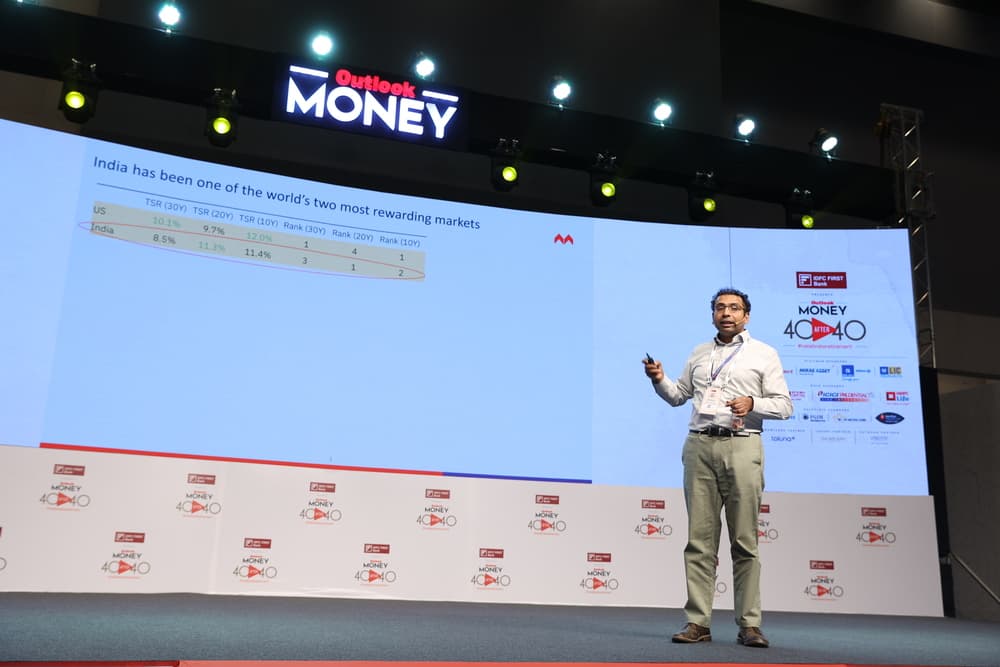In India, 100 Mn Families Heading For Retirement Disaster, Says Saurabh Mukherjea
The path to financial security and a decent corpus is clear and achievable; it requires adherence to the time-tested strategy of compounding steadily, says Mukherjea.
The path to financial security and a decent corpus is clear and achievable; it requires adherence to the time-tested strategy of compounding steadily, says Mukherjea.

40after40 Retirement Expo at JIO World Convention Centre, Mumbai
India has emerged as a formidable force in the global economic landscape, challenging traditional narratives. India is on the cusp of overtaking America in terms of compounding returns, showcasing a remarkable feat over 10, 20, and 30 years. The statistics speak volumes—Indian stock markets, delivering dollar returns, have become competitive on a global scale.
“A testament to this financial prowess is that, over the last decade, Indian stock markets have generated a staggering $2 trillion of wealth, second only to America. This surge in wealth creation has propelled India and America to account for 60 per cent of the world’s stock market compounding, relegating the rest of the world to the status of a mere holiday destination for investors,” Says Saurabh Mukherjea, Founder of Marcellus Investment Managers.
Advertisement
He further highlighted that financial transformation has yielded mind-boggling statistics and sparked a frenzy of risk-taking and financialisation. D-mat accounts have witnessed a tenfold increase in the past decade, with a tripling in the last three years alone. “This surge in investor interest is reflected in the impressive turnout at conferences like Outlook Money’s prestigious event”, says Mukherjea.
Also Read: Navigating Financial Prosperity Through Disciplined Investing
Advertisement
He adds that another striking indicator of this financial boom is the mutual fund industry, which is experiencing an unprecedented upswing. Mutual fund inflows have skyrocketed, increasing tenfold in the last decade. “Despite being among the poorest countries in per capita income, India is pumping a staggering $160 billion into the financial system annually. This massive inflow, comprising contributions from NPS, mutual funds, life insurance, general insurance, and the stock market, has tripled in a decade. The impact of this inflow is evident in the drastic reduction in the cost of capital, with government bond yields dropping from 13.5 per cent to 7 per cent over the past 20 years,” says Mukherjea.
In essence, India’s financial evolution is not just a narrative of economic growth but a story of unprecedented financial participation, risk-taking, and wealth creation. The surge in flows into the financial system has fundamentally altered the cost of capital landscape, setting the stage for a new era of financial opportunities and growth.
Also Read: At 40 I Became Courageous: Neelesh Misra Shares Story Of Continuity At 40After40 Retirement Expo
Despite this surge, In India, 100 million families are heading for a retirement disaster because they are not saving enough or don’t have planning in place. He gave an example of a family of age 40 years living on a modest income of Rs 25 lakh a year, devoid of luxuries like BMWs or extravagant trips to Dubai. Aiming to work for 20 more years, envision a retirement at 60, assuming they live until 85. Assuming a 10 per cent post-tax return on investments and a 6 per cent inflation rate in the cost of living, they would need a financial corpus of Rs 1.1 crore per annum during retirement years. Translating this into today’s money, the bare minimum financial savings required at retirement amounts to six crores.
If you invest a lump sum of Rs 90 lakh at 40 and compound it at a post-tax rate of 10 per cent per annum for 20 years, you will reach a substantial amount. This straightforward path, as outlined, requires clarity of thought and a disciplined approach. However, despite the simplicity and viability of this path, there’s a twist in the tale. Even within our industry, many individuals have intentionally clouded this clear route. Instead of adhering to the straightforward strategy of steadily compounding at 10 per cent, some opt for shortcuts or speculative moves. They might aim for quick gains, attempting to build a Rs 1 crore lump sum between the ages of 40 and 50, potentially exposing themselves to higher risks.
The essence of the message is that the fundamental and proven path is to stick to consistent compounding at a reasonable rate. The path to financial security and a decent corpus is clear and achievable. It requires adherence to the time-tested strategy of compounding steadily at 10 per cent per annum. The choice lies in whether to follow this proven path or be swayed by the allure of shortcuts and speculative manoeuvres.
Advertisement
Financial life changes completely on crossing the age of 60, due to retirement from an active work life, increased dependence on retirement corpus and a change in risk-taking capacity. So, the age of 60 is often seen as a cut-off year to accomplish financially crucial things.
You need to plan many things when you retire, but one of the important aspects that you must not miss out on is related to securing the financial well-being of your spouse.
Mastering money management is a long process with lessons at each step, but there is a start to every journey. The question is, when would you start that trip?
Get all the latest stories delivered to your inbox
Advertisement
Get all the latest stories delivered to your inbox